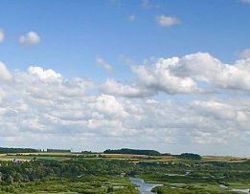Air
Air is a colorless, odorless and tasteless mixture of gases consisting mostly of nitrogen (N2) and oxygen (O2). It is the part of Earth's atmosphere that humans and all other animals breathe in order to obtain the oxygen needed to sustain life.
The Earth's atmosphere not only contains the air we breathe, it also holds clouds of moisture (water vapor) that become the water we drink. Furthermore, it protects us from meteors and harmful solar radiation and warms the Earth's surface by heat retention. In effect, the atmosphere is an envelope that protects all life on Earth.
The air may contain pollutants that originate from a variety of sources such as our industries and our vehicles, and can directly or indirectly affect our health and the natural environment. These effects may be experienced near the sources of air pollution and some air pollutants may be transported long distances by the wind, even across political boundaries.[1][2][3]
Composition of the atmospheric air
| ||||||||||||||||||||||||||||||||||||||||||||||||||||||||||||||||||||
The adjacent table lists the concentration of 14 gases present in filtered dry air. Two of the gases, nitrogen and oxygen make up 99.03 percent of the clean, dry air. The other listed gases total to 0.97 percent.
Note the amounts of greenhouse gases that are present: water vapor, carbon dioxide, methane, nitrous oxide, and ozone. Additional gases (not listed in the table) are also present in very minute amounts.
The atmospheric air is rarely, if ever, dry. Water vapor is nearly always present up to about 4% of the total volume. In the deserts regions, when dry winds are blowing, the water vapor content will be near zero. This climbs to near 3% on extremely hot/humid days. The upper limit of 4% is for tropical climates.
Unfiltered air contains minute amounts of various types of particulate matter derived from sources such as from dust, pollen and spores, sea spray, volcanoes, meteoroids and industrial activities.
The nitrogen cycle
The nitrogen in the air is also essential for life on Earth. It is incorporated into amino acids and proteins, and is part of the nucleic acids, such as DNA and RNA. In plants, nitrogen is used in chlorophyll which is essential for photosynthesis and further growth.
However, the free nitrogen in the atmosphere is mostly unusable by plants. It must first be transformed through bacterial conversion processes into forms usable by living organisms. That transformation (referred to as nitrogen fixation) is part the nitrogen cycle which is the circulating flow of nitrogen through the atmosphere, the soil of the Earth's crust and the Earth's water bodies.[5][6]
References
- ↑ Arya, S. Pal (1998). Air Pollution Meteorology and Dispersion, 1st Edition. Oxford University Press. ISBN 0-19-507398-3.
- ↑ Barrat, Rod (2001). Atmospheric Dispersion Modelling, 1st Edition. Earthscan Publications. ISBN 1-85383-642-7.
- ↑ Pielke, Roger A. (2001). Mesoscale Modeling, 2nd Edition. Elsevier. ISBN 0-12-554766-8.
- ↑ The Atmosphere From the website of the National Oceanic and Atmospheric Administration (NOAA) and the National Weather Service (NWS), Last updated May 5, 2009
- ↑ The Nitrogen Cycle 2008, Paul Billiet. From the Open Door Web Site , a reference source for both students and teachers.
- ↑ The Nitrogen Cycle: Nitrogen Transformations in Soil, Water, and Air. From a website page of the National Aeronautics and Space Administration (NASA).
